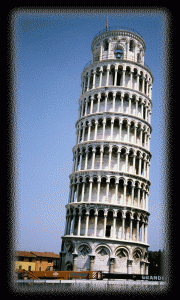Pisa Tower Dimensions
History
The foundation of the leaning  Tower of Pisa was put in place on August 9, 1173 and the completion of the tower took approximately 199 years. The tower has started to lean on the fifth year of its construction. Since its construction was very costly it was never considered to redo what was already built and start all over again. Due to the wars, building of the tower stopped momentarily. That actually saved the tower from falling over because it gave time for the ground beneath to settle.
Tower of Pisa was put in place on August 9, 1173 and the completion of the tower took approximately 199 years. The tower has started to lean on the fifth year of its construction. Since its construction was very costly it was never considered to redo what was already built and start all over again. Due to the wars, building of the tower stopped momentarily. That actually saved the tower from falling over because it gave time for the ground beneath to settle.
In 1272, the construction of the leaning Tower of Pisa continued where architects made the walls on the leaning side of the tower higher in order to straighten it out. Three additional floors were constructed and then the work stopped again in 1284 because of another war. In 1319, they added the seventh floor and in 1372, they added the bell chamber which completed the whole edifice.
Dimensions
The highest point of the leaning Tower of Pisa is 186 feet from its ground level. The roof of the tower on the leaning side is 183 feet above the ground making it three feet lower than on the other side. The tower is leaning at an angle of about four degrees. The roof of the tower is actually close to 13 feet off from the center on the southwest side.
The leaning Tower of Pisa has 294 stairs on the staircase facing south and 296 stairs on the staircase facing north. The walls on the base of the tower are notably thicker for the reason that it must hold up the rest of the weight of the tower. The thickness of the bottom walls are about 13.5 feet while the top walls are about eight feet thick. The total weight of the leaning Tower of Pisa is believed to be approximately 16,000 tons.
Purpose
The main purpose of the leaning Tower of Pisa is to be the campanile for the Cathedral of Pisa. The tower is situated alongside the Cathedral and Bapistry of Pisa within the Piazza dei Miracoli. Located just behind the cathedral, the tower is actually a freestanding bell tower and it has seven bells in its bell chamber. Each of the seven bells represents one note in our musical scale. For centuries, the leaning Tower of Pisa has become a great tourist attraction in the country of Italy. It is considered to be among the most recognizable structures of the world and is one of the most visited tourist attractions all over the country.





